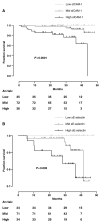Levels of soluble endothelium-derived adhesion molecules in patients with sickle cell disease are associated with pulmonary hypertension, organ dysfunction, and mortality
- PMID: 16156864
- PMCID: PMC2065864
- DOI: 10.1111/j.1365-2141.2005.05701.x
Levels of soluble endothelium-derived adhesion molecules in patients with sickle cell disease are associated with pulmonary hypertension, organ dysfunction, and mortality
Abstract
Endothelial cell adhesion molecules orchestrate the recruitment and binding of inflammatory cells to vascular endothelium. With endothelial dysfunction and vascular injury, the levels of endothelial bound and soluble adhesion molecules increase. Such expression is modulated by nitric oxide (NO), and in patients with sickle cell disease (SCD), these levels are inversely associated with measures of NO bioavailability. To further evaluate the role of endothelial dysfunction in a population study of SCD, we have measured the levels of soluble endothelium-derived adhesion molecules in the plasma specimens of 160 adult patients with SCD during steady state. Consistent with a link between endothelial dysfunction and end-organ disease, we found that higher levels of soluble vascular cell adhesion molecule-1 (sVCAM-1) were associated with markers indicating renal dysfunction and hepatic impairment. Analysis of soluble intercellular cell adhesion molecule-1 (sICAM-1), sE-selectin and sP-selectin levels indicated partially overlapping associations with sVCAM-1, with an additional association with inflammatory stress and triglyceride levels. Importantly, increased soluble adhesion molecule expression correlated with severity of pulmonary hypertension, a clinical manifestation of endothelial dysfunction. Soluble VCAM-1, ICAM-1, and E-selectin were independently associated with the risk of mortality in this cohort. Our data are consistent with steady state levels of soluble adhesion molecules as markers of pulmonary hypertension and risk of death.
Figures



References
-
- Alon R, Feigelson S. From rolling to arrest on blood vessels: leukocyte tap dancing on endothelial integrin ligands and chemokines at sub-second contacts. Seminars in Immunology. 2002;14:93–104. - PubMed
-
- Aslan M, Freeman BA. Oxidant-mediated impairment of nitric oxide signaling in sickle cell disease – mechanisms and consequences. Cell Molecular Biology. 2004;50:95–105. - PubMed
-
- Aslan M, Thornley-Brown D, Freeman BA. Reactive species in sickle cell disease. Annals of the New York Academy of Sciences. 2000;899:375–391. - PubMed
-
- Aslan M, Ryan TM, Adler B, Townes TM, Parks DA, Thompson JA, Tousson A, Gladwin MT, Patel RP, Tarpey MM, Batinic-Haberle I, White CR, Freeman BA. Oxygen radical inhibition of nitric oxide-dependent vascular function in sickle cell disease. Proceedings of the National Academy of Sciences of the United States of America. 2001;98:15215–15220. - PMC - PubMed
-
- Aslan M, Ryan TM, Townes TM, Coward L, Kirk MC, Barnes S, Alexander CB, Rosenfeld SS, Freeman BA. Nitric oxide-dependent generation of reactive species in sickle cell disease. Actin tyrosine induces defective cytoskeletal polymerization. Journal of Biological Chemistry. 2003;278:4194–4204. - PubMed
Publication types
MeSH terms
Substances
Grants and funding
LinkOut - more resources
Full Text Sources
Other Literature Sources
Medical
Miscellaneous

